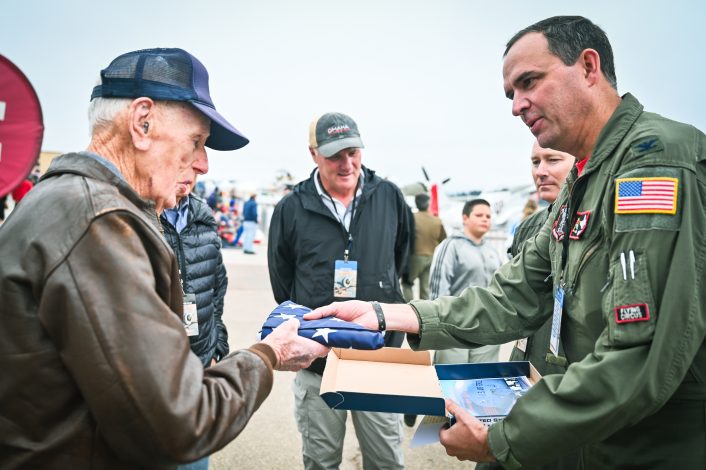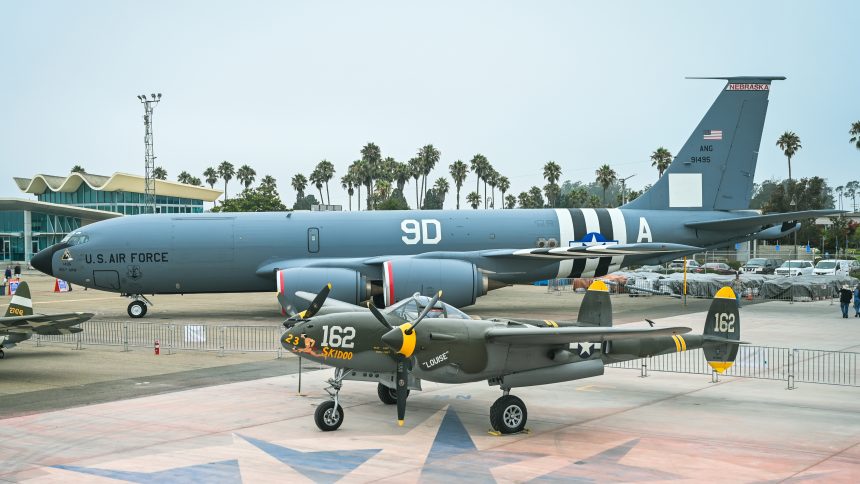The KC-135 heritage jet will remain in service with its WWII-inspired paint scheme until 2025.
The Nebraska Air National Guard’s 155th Air Refueling Wing (ARW) unveiled a historic KC-135R Stratotanker painted in a striking WWII-inspired heritage scheme during the Central Coast AirFest in California, on Sept. 21-22, 2024. The paint scheme is a tribute to Capt. Jim Kunkle, a 102-year-old veteran and former P-38 pilot from the 401st Fighter Squadron. This project highlights the unique bond between the modern Air National Guard unit and the squadron’s WWII legacy, celebrating both Kunkle’s service and the history of the unit he once served.
Honoring a WWII Hero
The connection between Capt. Kunkle and the 155th ARW began in 2018 when members of the Nebraska-based unit discovered a “Toast of the Host” patch, which belonged to the 401st Fighter Squadron, the unit Kunkle flew with during WWII, a public release explains. It was a chance discovery, but one that led the Airmen to reach out to Kunkle, who was still alive and one of the last surviving members of the 401st. The relationship developed from there, and by 2023, the squadron decided to honor Kunkle with a commemorative paint scheme on one of its KC-135 tankers.
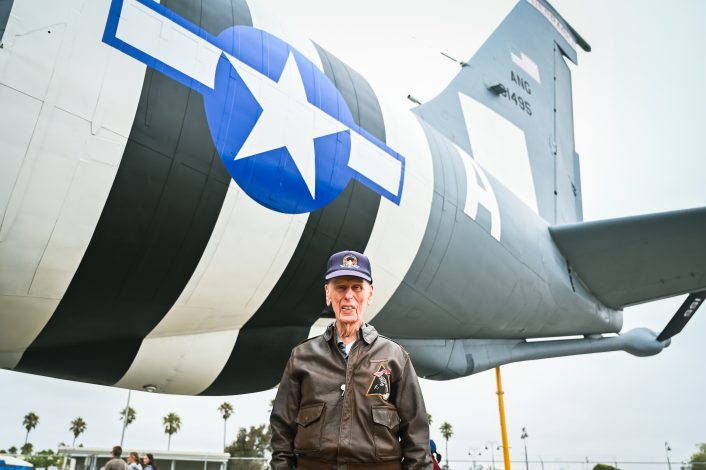
“This project is really special for us,” said Col. Andrew Malousek, vice wing commander of the 155th ARW. “It connects our past with the present and honors a remarkable legacy. Many WWII veterans are no longer with us, and the fact that we have the opportunity to celebrate Captain Kunkle and his service is incredible.” For Malousek and the rest of the unit, the KC-135’s new look is more than just a tribute; it’s a living connection to history.
The newly painted KC-135 features black-and-white invasion stripes, a hallmark of WWII aircraft involved in the D-Day invasion of Normandy, as well as nose art inspired by Kunkle’s own P-38 Lightning. These visual elements are meant to bring the legacy of the 401st Fighter Squadron, part of the 370th Fighter Group under the 9th Air Force, into the present. After the war, the 401st transformed into the 173rd Air Refueling Squadron, which is now part of the 155th ARW.
A Connection to the Past
The process of connecting with Kunkle and designing the paint scheme was deeply personal for the Airmen of the 155th. Kunkle himself was actively involved in the project, sharing his memories and even getting a ride aboard a KC-135 on Apr. 25, 2023, during which he witnessed a refueling mission with F-15 fighter jets. “They came out and gave me a ride over the Pacific range, and we got to refuel some F-15s. I got to see firsthand what I had only heard about, what modern fighters can do, and what we can do for them. It’s been a terrific experience being with all the folks from Nebraska,” Kunkle said, reflecting on the experience.
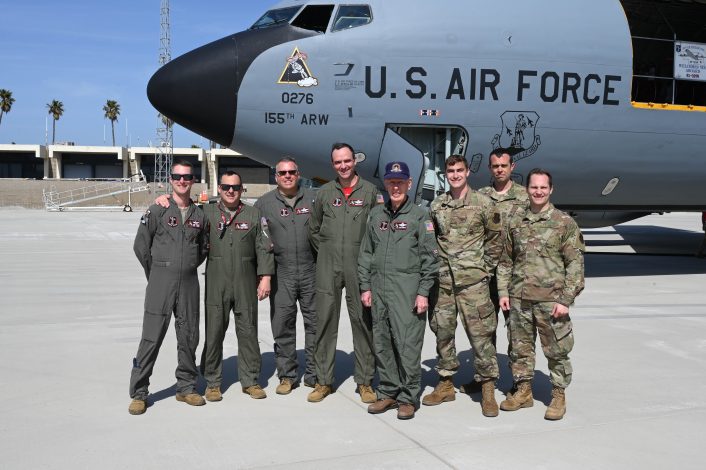
The commemorative paint scheme is not just a symbolic gesture; it serves as a way for the modern generation of airmen to connect with the past. “We are the living link to their legacy,” said Col. Malousek. “It’s been incredible to watch our Airmen engage with Kunkle’s story and take pride in carrying forward that heritage. Whether or not they met him in person, knowing the story behind the jet gives our team a sense of connection and motivation.”
Kunkle’s emotional response to the tribute was clear when he saw the finished aircraft. “I would have to tell you, it’s been emotional for me,” Kunkle said. “The stripes were a big surprise. I couldn’t believe it.”
The Invasion Stripes: A Nod to D-Day
One of the most striking features of the KC-135’s new look is the black-and-white invasion stripes, which hold significant historical meaning. The stripes, hastily painted on Allied aircraft in the days leading up to the D-Day invasion, were designed to prevent friendly fire as massive fleets of aircraft flew over the English Channel and into enemy-occupied France. The sheer scale of the operation, known as “Operation Overlord,” required quick identification of friendly aircraft to avoid accidents amid the chaos of the invasion.
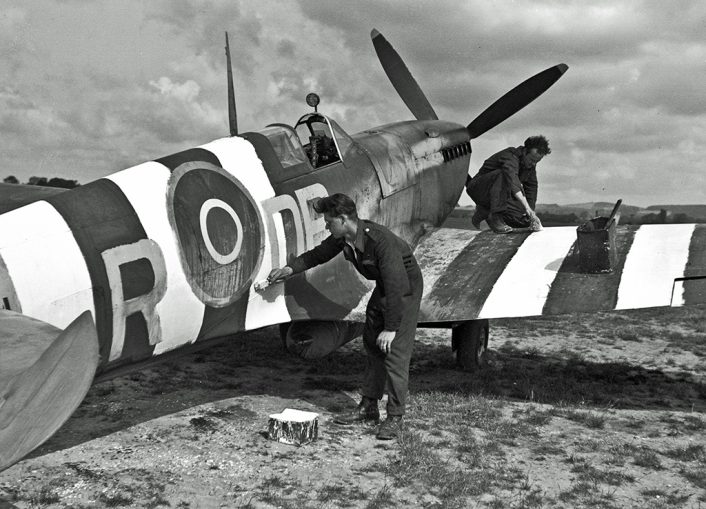
In total, over 11,500 Allied aircraft flew nearly 15,000 sorties on June 6, 1944—D-Day itself—with most of them sporting the distinctive stripes. These markings, while effective in identifying friend from foe, were also ordered to be removed just a month after D-Day, as they interfered with the aircraft’s camouflage. However, the invasion stripes have lived on in various commemorative paint schemes on military aircraft, serving as a visual reminder of one of the most significant operations in military history (as well as in combat….as shown in Ukraine).
Keeping the Legacy Alive
The heritage paint scheme on the KC-135 Stratotanker will remain in place until 2025, serving as a flying tribute to Kunkle and the men of the 401st Fighter Squadron. But the legacy will last far beyond the paint. During the unveiling, Kunkle toured the aircraft and even signed a bulkhead inside the jet with a message honoring the 401st Fighter Squadron. He also penned a note on a piece of test-painted sheet metal, thanking the maintainers who worked tirelessly to bring the project to life.
To commemorate the occasion, the 155th ARW presented Kunkle with a U.S. flag that had flown aboard the KC-135 during a refueling mission, as well as a California Air National Guard F-15 from the same mission he took part in last year. It was an emotional moment for Kunkle, who reflected on how much this tribute meant to him. “Your airplane really represents the 401st to me and all my friends. For whatever reason, I’m still here, and I guess I’m the last man standing.”
